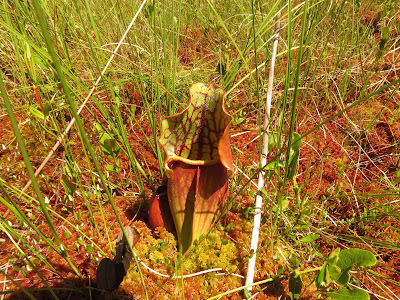We found Common Butterwort, a new species for me, growing along seeps and the outflows of small streams on the rocky shores of the Lake Huron side of the Bruce Peninsula. The greasy leaves trap small insects which are digested for their nutrients.
Similarly, the sundews trap insects on their sticky leaves. This is Linear-leaved Sundew, a new species for me although it seems to be the most common sundew on the Bruce Peninsula. The Round-leaved and Spatulate-leaved Sundews I see in Algonquin Park have much shorter, broader leaves.
The most spectacular of our carnivorous plants is definitely the Pitcher Plant. The slippery pitchers drown and digest insects, and are often large enough to be seen from quite a distance away in bogs. This is what they normally look like (this photo is from several years ago in Algonquin as the specimens there are generally much nicer than those we saw on the Bruce):
You might be a little surprised when I tell you that the largest leaves in this photo below also belong to a Pitcher Plant:
I came across this odd plant growing in a partially-shaded coniferous forest, and quickly realised that it was a very strange Pitcher Plant. Note the uppermost leaf that does have a very small pitcher opening.
Pitcher Plants normally grow in bogs, where sunlight is abundant but nutrients are scarce. The individual above, in atypical habitat with ample nutrients but less than full sun, has grown broad leaves to catch the sun rather than pitchers for extracting nutrients from insects. I'm surpised it managed to get established here and I find it very impressive for a plant to be able to adjust it's growth habits this much.
Well doing some research I came across this fantastically well-written and comprehensive website about carnivorous plants. Highly recommended if you have any interest in this fascinating group.





The first picture looks like Purple Bladderwort not Common Bladderwort.
ReplyDeleteNot a bladderworts but a butterwort, a related group, but with a completely different trapping mechanism.
Delete🤦♂️my guy thats a common me xican butter wort not a bladderwort. The species that your thinking of are found along the Bruce peninsula and are golden horned bladder worts (You can find this specific specimen in singing sands aswell).
DeleteSilly me, I didn't catch the "butter" vs "bladder", I should have read it carefully instead of jumping to conclusion. It also is not aquatic and may not exist in the western part of the Nipissing District where I live. Common Butterwort is not in the Algonquin checklist. Personally I found Purple Bladderwort myself about a week ago in a pond across from Martin River Provincial Park.
ReplyDelete